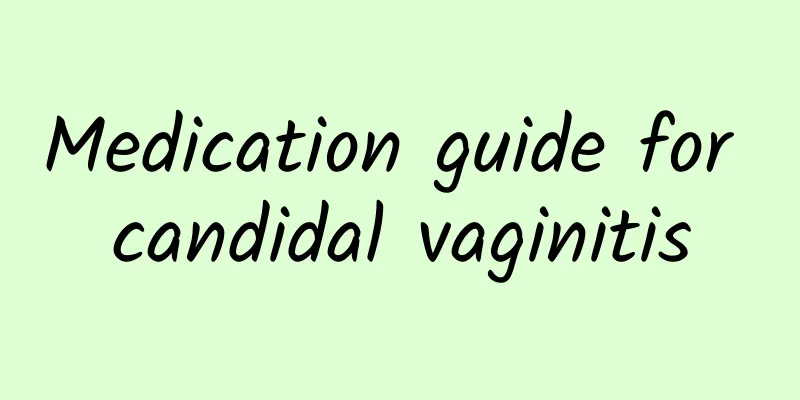Medication guide for candidal vaginitis

|
Although candidal vaginitis is a common gynecological disease, it is easy to cure if the right method is used. Clinically, it has been proven that candidal vaginitis is a gynecological disease caused by cross-infection during sexual intercourse. So how to use medicine for candidal vaginitis? Let's learn about it together. Fungal vaginitis is caused by Candida albicans and is highly contagious. This disease is more common in pregnant women and diabetic patients, and teenage girls can also suffer from it. In addition, patients who use antibiotics, hormones or receive radiotherapy for a long time are also prone to the disease due to the disorder of the bacterial flora. Fungi can parasitize in the vaginal vestibule and vagina. When the glycogen in the vaginal epithelial cells increases and the acidity increases, the bacteria can multiply rapidly and cause inflammation. The main symptom of candidal vaginitis is vulvar itching, which usually starts from the inner side of the labia minora and gradually spreads to the entire vulva. Severe itching can make the patient restless, affecting work, study and sleep. In addition, there is a burning sensation in the vulva and an increase in leucorrhea, which is dreg-like or watery. Vaginitis candidiasis is relatively easy to cure, and the main treatment methods are as follows: (1) Topical application of nystatin. Nystatin tablets can be inserted deep into the vagina, once a night, 50,000-100,000 units each time, for a course of 7-10 days. If conditions permit, nystatin cold cream (50,000 units/g) can be applied to the vulva skin. Nystatin can also be taken orally. (2) Every night or every other day, rinse the vulva and vagina with soda water before going to bed. After rinsing, apply gentian violet solution to the vaginal wall and vulva. Five times is a course of treatment. (3) Traditional Chinese medicine therapy. Mix 1 tube of Bingpengsan and 2 tubes of Xileisan and spray them on the vaginal wall once a day for a course of 10 days. Decoct 3-5 leaves (or stems) of mugwort or garlic stems and wash externally for a course of 7 days. Decoct 15 grams each of Phellodendron chinense, Taraxacum mongolicum, Cnidium monnieri and Sophora flavescens and rub the vulva and vagina with the decoction first and then wash and rub twice a day. During treatment, the following precautions should be taken: the basins for washing feet and the basins for washing the vulva should be separated, not used randomly or borrowed, and disinfected with boiling water frequently after use; underwear should be changed frequently, and boiled and disinfected after washing every day, and should not be worn again; medication for the vulva and vagina should be applied at the same time; the concentration of gentian violet solution should not be too high, and it should not be applied too frequently, so as not to cause vulvar or vaginal ulcers |
<<: Analysis of the etiology of recurrent candidal vaginitis
>>: Why is vaginal candidiasis difficult to cure?
Recommend
What medicine is good for women with amenorrhea
Amenorrhea is a common manifestation of abnormal ...
How to relieve pelvic peritonitis
Pelvic peritonitis is a gynecological disease tha...
How to prevent cervical erosion from becoming cancerous? 5 ways to prevent cervical erosion from becoming cancerous
Cervical erosion is a very common gynecological d...
Jiang Gui Liang Jiang Congee is suitable for patients with dysmenorrhea caused by cold stagnation and qi stagnation
Cold stagnation and qi stagnation is a common typ...
I can’t lose weight after giving birth! Body sculpture outpatient consultation increased by 30%
The birth boom in the Year of the Dragon has brou...
What are the causes of non-menstrual bleeding?
What are the causes of non-menstrual bleeding? No...
Eat hotpot tonic food without worrying about getting fat! Choose the right soup base and win half the prize
Mutton hotpot, ginger duck, spicy hotpot, kimchi ...
What to eat for women with cervical erosion? Share 8 dietary treatments for cervical erosion
Cervical erosion is quite harmful to female frien...
What to do if your child is too fat? Troubling issues during development
Why can’t I lose weight? The first thing to consi...
How to regulate irregular menstrual cycle?
How to regulate irregular menstrual cycle? Gyneco...
What are the ways to relieve dysmenorrhea? Tips to relieve dysmenorrhea pain
What are the ways to relieve dysmenorrhea? Tips t...
Be careful of bacterial vaginitis if you abuse private washes!
Some female friends always have a damp and wet fe...
Is it safe to have sex with a condom 18 days after an abortion?
Abortion refers to artificial abortion. It is gen...
How to treat uterine fibroids during 40 days of pregnancy?
If uterine fibroids are found after pregnancy, a ...
23 stalls at Ningxia Night Market take the lead in labeling product calories
You can also be more careful about the calories y...









